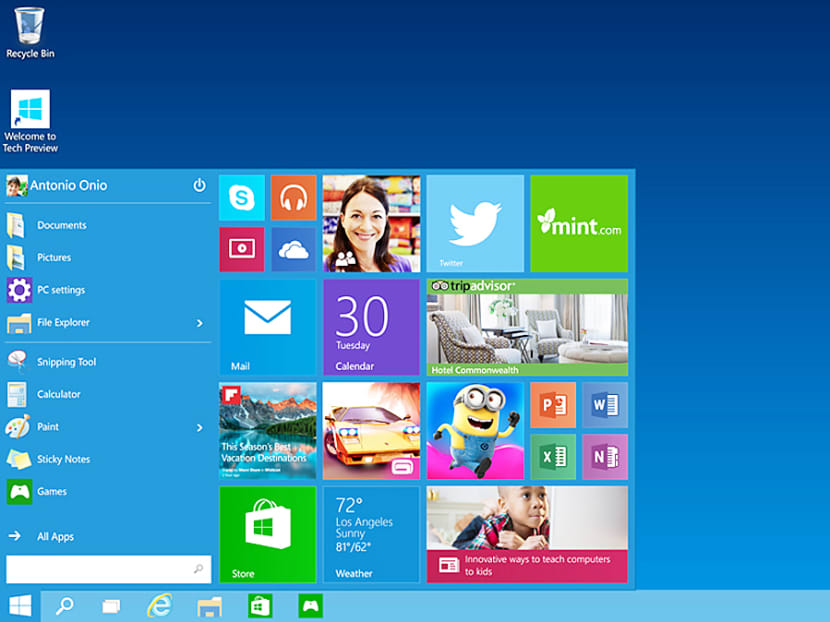Microsoft makes a leap with new Windows 10
SEATTLE — Microsoft showed a first glimpse of its newest Windows operating system, touting new features such as a custom application store and added security, seeking to woo businesses that shunned the previous version as confusing and hard to use.

Windows 10 restores the Start Menu and will allow corporations to tailor the app store for their own users. Photo: AP
SEATTLE — Microsoft showed a first glimpse of its newest Windows operating system, touting new features such as a custom application store and added security, seeking to woo businesses that shunned the previous version as confusing and hard to use.
Called Windows 10, the system restores the Start Menu and will allow corporations to tailor the app store for their own users, Windows chief Terry Myerson said at an event on Tuesday in San Francisco. The system, designed to run on mobile and desktop devices, will separate corporate and personal data on individual machines to bolster security, he said.
“Windows 10 embodies what our consumer and enterprise customers are demanding and what we will deliver,” Mr Myerson said. “It will run on the smallest Internet of Things and data centres worldwide.”
In 2012, Microsoft revamped Windows for personal computers in an attempt to win back consumers defecting to Apple’s smartphones and tablets and devices running Google software. That version, Windows 8, added a touchscreen-based design to the Windows operating system’s familiar desktop layout, a change many users found confusing. Windows 8 was poorly received by consumers and irked business customers, and Microsoft later updated the system so some features could be disabled.
Now, the company is refocusing on corporate customers, seeking to revive sales growth as chief executive officer Satya Nadella also steers the firm to develop apps and services for rival operating systems and pushes more Internet-based cloud-computing services.
“The enterprise is Microsoft’s bread and butter — as much as you want to focus on the consumer, their wheelhouse is the enterprise,” said Mr Daniel Ives, an analyst at FBR Capital Markets. “They have their work cut out for them internally and externally. There are a lot of naysayers.”
In naming the system Windows 10, Microsoft is skipping a version of the operating system called Windows 9, a bid to signify that the release is a significant jump from the previous version. The design attempts to blend some of the more successful aspects of Windows 8 with the familiar parts of Windows 7 that appealed to corporate customers. The Start Menu will use the older design and a second column with the boxy tiles of Windows 8. Applications built for Windows 8 will also run in individual windows.
Microsoft is also working on a design that will automatically switch Windows modes depending on whether a device is being used as a tablet or a laptop with a mouse and keyboard plugged in. In the tablet mode, the design is based on the touch-focused Windows 8, while the laptop mode is more like Windows 7.
Microsoft wants Windows to be at the centre of people’s digital lives, where all content can be portable and users can toggle easily between phones, tablets, laptops and PCs. At the same time, the failure of Windows to gain market share on mobile phones and tablets means that the strategy must also encompass first-class experiences on rival devices, said Mr Wes Miller, an analyst at Directions on Microsoft.
“At some point, Windows has empowered each of us,” Mr Myerson said at the event, which was called a technical preview. “But we all know that the world in which Windows had grown up has changed. Devices now outnumber people.”
The company chose to show what is a very early and unfinished version of Windows to convey to customers that it wants feedback and will build the final product based on that input — a change from Windows 8, where the development process was more closed, and partners and customers were brought in later.
When Microsoft first unveiled Windows 8 to developers in 2011, the attitude was “this is Windows, you will like it”, Mr Miller said. Now, the posture is more, “we really hope you like it, let us know if you don’t”, he said.
“The consumers of today are often the enterprise users of tomorrow,” Mr Miller said. “We have to see something that keeps moving the ball forward for consumers and tablets and enterprises.” BLOOMBERG





